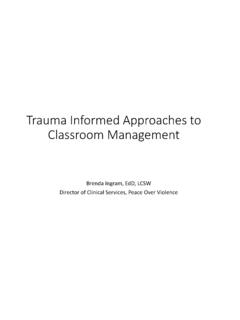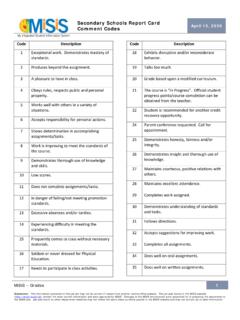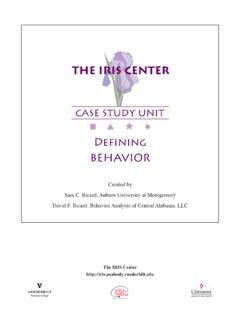Transcription of Data Collection Methods - Schoolwires
1 Data Collection Methods Reference Guide Frequency/Event & Rate Recording Duration Recording Interval Recording Latency Recording Time Sampling Recording Permanent Product ABC Analysis Scatterplot FREQUENCY / EVENT & RATE RECORDING Description: These Methods involve counting the number of times a behavior occurs in a specific time period. Use these Methods if the behavior can be easily counted and the behavior has a clear beginning and end. Do not use these Methods if the behavior is occurring at such a high rate that an accurate count is impossible ( , pencil tapping) or the behavior occurs for extended periods of time ( , 2 tantrums, but the duration of each tantrum is one hour).
2 Examples: Event recording is best for behaviors with a distinct beginning and end. Event recording has been used to measure behaviors such as: -Task initiation and protests to task demands -Inappropriate sitting and littering -Correct and incorrect academic responses -Tardiness Teachers have used event recording to measure their own behaviors, such as.
3 -Praise statements -Response opportunities provided to students Event recording is best for behaviors that occur with enough in between to distinguish between the end of one response and the onset of another. Special Considerations: A frequency measure should be used only when the length of observation time is consistent from day to day ( , always 2 hours). A rate measure should be used if the length of observation time varies from day to day ( , 60 minutes on Monday, 300 minutes on Tuesday).
4 Summarizing the Data: Frequency: At the end of the observation period, total number of occurrences. For example, Anna left her seat 5 times during 7th period. Rate: Count the number of times the behavior occurred in the time observed. Divide the count by the length of time the behavior was observed. For example, if Anna kicked a peer 30 times in a 10 minute observation, the rate would be 3 kicks per minute (30 kicks divided by 10= 3 kicks per minute). DURATION RECORDING Description: This method documents the length of the behavior by recording the time the behavior begins and ends.
5 Use this method if your primary concern is the length of time the student engages in the behavior and the behavior has a clear beginning and end. Do not use this method if the behavior occurs with high frequency or the behavior starts and stops rapidly. Examples: Duration recording is appropriate for behaviors that have a distinct beginning and ending or for those that occur at such high rates that it would be difficult to get an accurate frequency count ( , number of taps during pencil, finger, or toe tapping).
6 Duration recording has been used to measure behaviors such as: -On Task: Looking at the assignment, writing and asking questions related to the topic, using assigned materials, and following teacher directions -Compliance to task demands -Academic writing tasks Consider collecting frequency data for the target behavior in combination with duration recording to provide a more accurate picture of behavior .
7 Special considerations: It can sometimes be difficult to accurately record the exact duration of the behavior . On the other hand, duration recording not only tells us how long the student engages in the behavior , but it automatically provides us with how many times the behavior occurred. Summarizing the Data: Duration can be summarized in two different ways: Percentage of observation with behavior : Sum the total number of min/sec/hrs that the behavior occurred during the observation, divided the sum by the total number of min/sec/hrs of the observation, and multiply by 100.
8 Average Duration of behavior : Sum the total durations and divide by the total occurrences. Example: During a 60 minute observation, david had 3 tantrums that lasted 3 minutes, 7 minutes, and then 5 minutes with a total duration of 15 minutes. The % of observation with behavior = 15 minutes divided by 60 minutes= .25 times 100 = Tantrums occurred during 25% of the observation. Average duration 15 minutes divided by 3 tantrums = Average of 5 minutes per tantrum. INTERVAL RECORDING Description: Interval recording documents whether a behavior occurred during a particular period.
9 In order to determine this, an observation period is divided into brief intervals. At the end of each of these, the observer records whether or not a behavior has occurred. There are two types of interval recording: whole and partial interval. When utilizing whole-interval recording, an observer indicates whether the behavior occurred during the entire time. (Example: A student worked on an assignment during an entire thirty-second interval.) When utilizing partial-interval recording, an observer indicates whether the behavior occurred at any point during the time interval. (Example: A student worked on an assignment during fifteen seconds of a thirty-second interval.)
10 The record indicates that the behavior occurred.) Examples: Interval recording is used when it is difficult or impractical to constantly observe behavior . Interval recording is used for continuous behaviors or for those behaviors whose onset and end are difficult to distinguish because the behaviors occur at such high rates. -Whole-interval recording yields data on the total duration of the behavior . -Partial-interval recording yields data on the proportion of the observations period that the behavior occurred.






